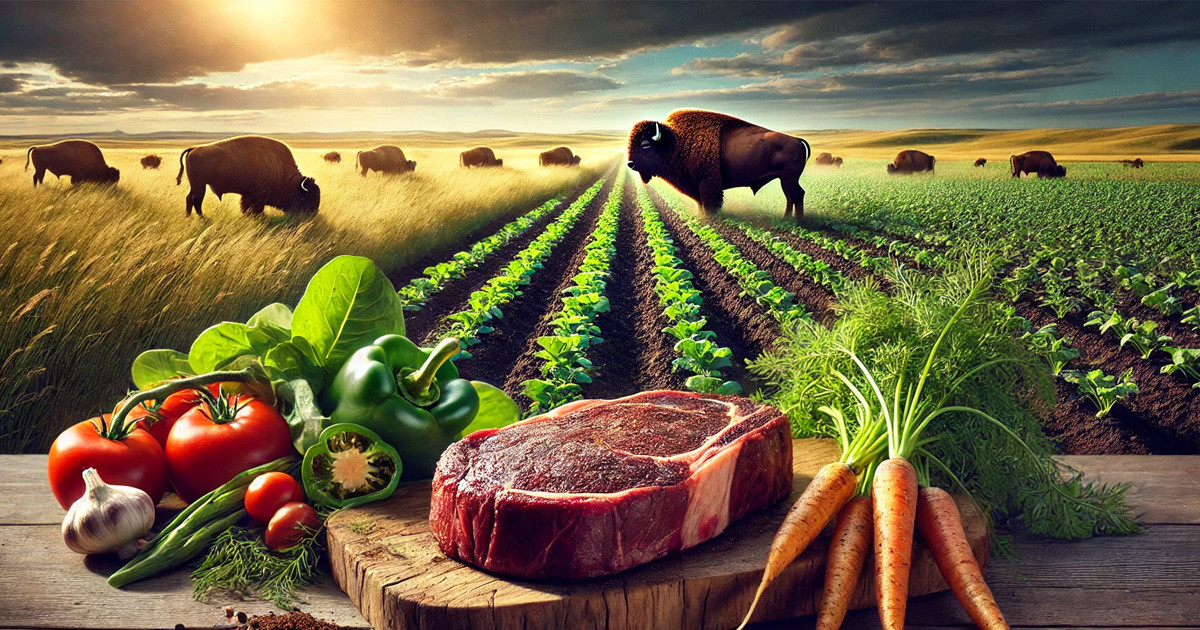Posted by James McMillin on Apr 7th 2025
Vegetarian/Vegan Diets are Only Possible because of Meat Eaters
As someone who prioritizes obtaining my meat from ethical sources (link to ethic blog page), it can be excruciating to listen to a self-righteous vegetarian or vegan demeaning my own dietary decisions while espousing the virtues of their own. I've come to settle on the thought that if someone is rude enough to verbally berate me or attempt to convince me that their meat-free diet is morally superior to my own, that I will do them the favor of enlightening them exactly how dietary, monetary, and moral choices work.
Personally, I believe we are all on our own journeys and need to do our own critical thinking. Whenever someone attempts to force me into thinking their way by moral coercion however, returning the favor sometimes feels like the right thing to do.
As with everything else terrestrial, it all goes back to the soil. Soil is created through a process involving animals, plants, minerals, and microorganisms. Microorganisms colonize structures, breaking down minerals and synthesizing nutrients and bioavailable compounds. Eventually, plants can take hold and further break down minerals. Plants often form symbiotic relationships with bacteria and fungi, feeding sugars to microorganisms along the roots in exchange for valuable plant compounds.
Animals, such as bison, graze the plants or grass. When done adequately but not overly (yes, overgrazing is a real issue, even with 100% grass-fed & finished operations), the grazing and walking over the earth can encourage the grass to grow faster than it would without disturbance. Additionally, bison and rumens process grass efficiently, defecating out patties that are high in carbon, seeds, microorganisms and structures.
Carbon is wonderful at holding moisture and keeping water in our water tables and acquifers. It also is structural by definition, offering homes to microorganisms, worms, and is overall a vital aspect of any soil food web, or ecology of a soil system. Microorganisms and seeds take hold in the moisture-rich carbon, colonizing and germinating, reiterating the processes outlined above.
If you don't believe me that bison are efficient soil-builders, let's look at the Great Plains. This bread basket is an unbelievably rich source for the entire USA of food crops as well as water. Where did all this fertility come from? The Great Plains were home to tens of millions of bison, and even more pronghorn, deer, elk, and other grazing species before them (such as the North American camel, mastodons, mammoth, ancestors to pronghorn, North American horses, etc.). Collectively, these animals grazed, and pooped their whole lives through. Given enough time, these animals literally pooped out our wonderous American Serengeti!
My point outlining all of the above, is really that if you want to have fertile soil, animals are a necessary. They are a key variable to a complex equation.
However, does that mean we need to kill the animals? Why do they need to die, or why do we need to kill them? According to the vegetarian or vegan, we should allow the animals to live and move this cycle along on their own, right?
From a technical standpoint, the process of soil-building (and inherently, carbon and water-sequestriation) can be optimized. Allowed to go on its own, nature can run its course and produce incredibly lush soils. However, nature's course can also destroy soil and build deserts. So, it is uniquely the human being that can contribute to this system, optimizing it and implementing it in places it would not occur on its own. But...how do humans do this?
To answer this question, we should briefly visit the idea of incentivization. When anyone runs any kind of business, be it a ranch or farm, or something entirely different--that person is incentivized to produce more of a product when it is purchased. A business model by necessity demands that a product be profitable. So, when a consumer purchases the product, it signals to the business "Yes, this is in demand, and is profitable--do more of it to survive on the business landscape."
It is the case then that by purchasing bison meat, whether from a grocery store or rancher, we incentivize more bison to be produced. We signal to either grocery store, rancher, or both that we want more of this product. Assuming they are producing the product at a profit, they will take our money and produce more bison so they'll be ready for us to purchase again.
OK, so someone who is incentivized to produce bison (or cattle, or another rumen species) has something of a dilemma. Do they produce more bison on their finite ranch/property now to meet a high demand, or do they calculate what is sustainable to produce bison ad infinitum?
This is where the concept of regenerative ranching becomes an integral aspect of the equation. Some ranchers choose the former option and burn their land out, while others choose the latter, contributing to longterm fertility for generations to come. This is why knowing your rancher is paramount. Just because someone says their ranch or meat is regenerative does not mean it is really the case. It's an unregulated term, and speaking to your rancher about how they manage their land (holistic grazing, pasture management & rotation, etc. are some promising practices to listen for) is really the only way to know.
So, it is true that some ranching contributes to soil degradation and infertility.
However, as an informed and caring consumer, we can build soil by eating steak. If we incentivize and support ranchers who are practicing regenerative methods by buying their meat and goods, we tell them, "keep doing what you're doing. Keep building soil, keep increasing bison numbers, but don't do it too fast." By buying and consuming regenerative bison products, consumers can do their part while the ranchers do theirs. The rancher doing their job really means they are encouraging the natural process to unfold. Rather than allowing animals to linger too long by water holes or on a particularly-rich pasture, ranchers can optimize the regenerative process. They can test their soil and determine the carrying capacity of land, and how it might be different from last year. They manage animal populations for ideal levels, never undergrazing or overgrazing, and always keeping grass-growth (and therefore carbon sequestriation and soil-building) at optimal speed.
So why does an animal need to die for this process to occur? Because there must be an economic incentive to build soil. There must be an incentive for a rancher to optimize this process. And, we must keep this process privatized. Wildlife refuges and conservation-based properties require paid hunters to come cull animals. Populations must be managed somehow, and the ancient and perennial answer to that problem has been predation.
The simplest form of the argument is this: we need animals to build soil, and we need soil for vegetables, especially soil-intensive crops that are so often eaten by vegetarians and vegans (like maize/corn, wheat, soy, and sugarcane). The best way to produce soil is to operate an optimally-producing regenerative agricultural system, of which grazing animals such as bison are an integral part. So, if we buy meat from a regenerative rancher, we are directly contributing to the chain of production which also builds the soil that one day will grow vegetables, crops, or....more animals.
If you enjoyed or benefitted from this article, please consider purchasing some of our own regeneratively-ranched bison products, such as our 100% grass-fed bison tallow (great for both cooking and skincare), our 100% grass-fed bison pet treats, or our 100% grass-fed bison liver supplements.
Help us populate our beautiful and Pure Prairie with bison by purchasing these products!

